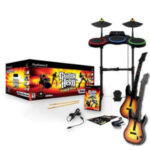Embarking on your guitar journey is an exciting endeavor, and for many, learning chords is the first step towards playing songs. There’s often debate about the best way to begin, and countless guitarists have their own opinions. This guide will walk you through essential guitar chords for beginners, focusing on effective practice methods for smooth chord transitions right from the start.
Why Start with Chords on Guitar?
While some educators advocate starting with single notes to build finger dexterity and proper fretting technique, especially for younger learners, there’s a strong case for introducing chords early on. Learning single notes within the first five frets is undoubtedly beneficial for developing initial skills. It allows beginners to get comfortable with finger placement and producing clear tones, one note at a time. Indeed, fretting a single note is often easier than forming a complete chord, and struggling with full chords initially can lead to frustration. This frustration might discourage some beginners, making them feel that guitar is too difficult to learn. For young students and even some adults, the sense of accomplishment from playing simple melodies can be a great motivator before tackling chords.
However, chords provide immediate gratification and open up a world of musical possibilities much faster. Playing chords allows beginners to strum along to simple songs, fostering a sense of musical achievement and encouraging continued practice. For many, this immediate connection to music is vital for staying motivated and engaged in the learning process right from the start with guitar chords.
Beginner-Friendly “Cheater” Chords
To ease into chord playing, especially for those who might find full chords challenging initially, “cheater” or simplified chords can be incredibly helpful. These are modified versions of chords that require fewer fingers, making them easier to fret and transition between. A great example is a simplified G major chord. Instead of using three fingers, you can play a G chord using just one finger on the 3rd fret of the high E string (fingering XX0003), omitting the fifth and sixth strings. Similarly, a “half C” chord, played only on the first three strings (fingering XXX010), offers a less demanding version of the C major chord.
These simplified chords are not intended to be permanent replacements for full chords, but rather stepping stones. They are excellent for building confidence and developing proper finger positioning without the immediate pressure of mastering complex fingerings. Interestingly, practicing C and G major scales can also indirectly aid in chord formation. Familiarity with finger placement on the fretboard through scale practice makes it a smoother transition to holding those finger positions to create C, G, and even a “middle of the neck F” chord.
Essential First Guitar Chords for Beginners
When it comes to teaching chords in a more traditional way, a structured approach is beneficial. A common starting point, as mentioned in Guitar Noise’s Absolute Beginners article, is to begin with E minor. This is often the first chord learned due to its relatively simple fingering. Following E minor, introducing E major, A minor (which uses a similar fingering to E major), and then A major creates a solid foundation. After these, it’s wise to pause and solidify these chords before moving on. Next, D major and B minor can be introduced, followed by C major and G major to round out a basic set of beginner chords.
Some instructors prefer to start with “two-finger” chords like E minor, E7, A7, and Am7. These can be particularly useful initially as they facilitate learning chord changes more easily. Depending on the student’s progress and comfort level, sticking with these simpler chords initially can be a good strategy, especially as they are conducive to practicing smooth transitions between chords.
Mastering Guitar Chord Transitions
Teaching chords in isolation is only half the battle. Equally, if not more, important is teaching chord transitions right from the outset. Chords are rarely played in isolation in music; they flow together to create melodies and harmonies. That’s why incorporating chord changes and transitions into the learning process from the beginning is crucial. Learning a simple song that utilizes just two or three chords is an excellent way to put this into practice immediately. A perfect example for beginners is “Horse With No Name.”
The song’s basic chord progression between Em (022000) and the “horse chord” (200200) provides a friendly and accessible way for beginners to get accustomed to the concept of chord movement and rhythmic changes. Beyond this simple transition, working on changes between E minor and E major, and progressing to E major and A minor, further develops essential chord switching skills.
Effective Chord Switching Practice
When practicing chord transitions, a structured approach is most effective. Start by dedicating eight beats to each chord. Use all downstrokes initially to focus on rhythm and chord clarity. Transition to the next chord and play it for another eight beats, then switch back to the first chord. Maintaining a steady rhythm is paramount, as chord changes in songs are inherently rhythmic. It’s more beneficial for a beginner to maintain a consistent rhythm, even if all notes aren’t perfectly clean initially, than to interrupt the rhythm to readjust fingerings. Start at a slow tempo; speed will come with repetition and consistent practice. Chord changing, like many guitar skills, improves significantly with patience and persistence. Developing good rhythm is often more challenging for beginners, making it a focal point in early chord transition practice.
As comfort increases with eight-beat changes, gradually decrease the duration to four beats per chord, then two, and eventually one beat per chord. This progression might take time, and it’s essential to be patient and consistent. In the meantime, there are many other aspects of guitar playing to explore and learn.
Chord transition exercises can be effectively grouped into pairs: E minor and E major, E major and A minor, A minor and A major, E minor and A major, and E major and A major. As mentioned earlier, seventh chords can sometimes be easier for beginners initially. Progressing to transitions between three different chords is the next logical step. Many popular songs utilize just E, A, and D chords, making them excellent choices for practice. “Wild Thing” and countless blues songs in A become accessible to beginners with mastery of these three chords.
Practice Tips Beyond Formal Practice
Incorporating chord practice into your daily routine doesn’t always require dedicated practice sessions. Chord changing can be practiced effectively during “free time.” For instance, watching television, even a football game, can become a practice opportunity. You don’t even need to strum; simply focus on transitioning between chords cleanly and efficiently. During commercial breaks, you can easily squeeze in ten minutes of focused chord change practice within a half-hour program. These short, frequent practice bursts accumulate and contribute significantly to muscle memory and dexterity.
Understanding Guitar Chord Roots for Beginners
From the outset of learning chords, understanding the concept of chord roots is incredibly beneficial. This knowledge not only helps in understanding which strings to strum or avoid (like not strumming the low E string in a D major chord) but also introduces the “bass/strum” technique. This technique involves striking the root note of the chord on the first beat of a measure, followed by strumming the full chord on the subsequent three beats. Teaching E, A, and D chords first makes this concept relatively easy to grasp for most beginners. The “bass/strum” technique is also subtly advantageous as hitting the open-string root note first provides a fraction of extra time to fully form the chord with the remaining fingers.
Another crucial reason for teaching the “bass/strum” technique early is its long-term benefit when learning chords like C and G, where the root note isn’t an open string. It cultivates an awareness of the importance of establishing the bass notes first in chord transitions. Beginners who learn to form a G chord by initially placing fingers on the higher strings might instinctively try to switch chords in the same manner. However, since chord changes often occur on a downstroke, this approach can lead to rhythmic inconsistencies. By emphasizing the root note and bass-first approach from the start with guitar chords, beginners develop a more grounded and rhythmically sound chord changing technique.
For further foundational knowledge, beginners should definitely explore the article Absolute Beginners Part 1: Chords for a comprehensive introduction to basic guitar chords.


